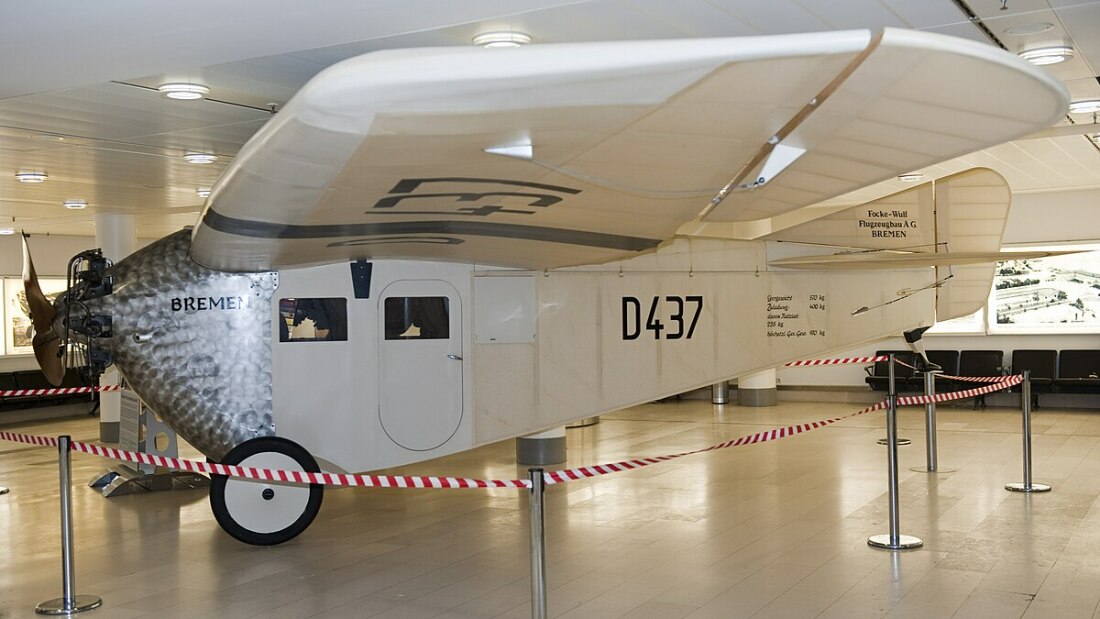The history of aircraft construction in Bremen – Part 1: 1924 – 1945
AviationThe chronology of aviation in the Hanseatic city
A century of aircraft construction in Bremen – the story starts in 1924 with the company "Focke-Wulf- Flugzeugbau AG". It marks the beginning of one of the Hanseatic city's most important industrial sectors.
In 2024, Bremen is celebrating "100 Years of Aircraft Construction" with a series of anniversary celebrations. The activities and events being held to mark the anniversary will not just attract specialists but also aircraft enthusiasts from around the world. However, the history of building aircraft in Bremen had modest beginnings: two pioneers who were fascinated by flying wanted to conquer the skies in aircraft of their own design.
The chronology of aircraft construction in Bremen, 1924 – 1945:
the very early days, up to 1924
In 1911, Henrich Focke (who was already involved in aircraft projects) met Georg Wulf, who would later become both his friend and business partner. They built the Focke-Kolthoff-Wulf A 5 and were working on an improved Version A 6 when World War I began. After the war, between 1920 and 1923, they worked on a new aircraft, the A VII "Storch". On May 6th, 1923, the Focke-Wulf Eindecker A VII aircraft received approval for use in public aviation. In 1923, using the A VII as capital, Henrich Focke and Georg Wulf decided to set up their own company. As the months of that year went by, they convinced Bremen merchants from well-known companies, such as the Haake-Beck brewery and Kaffee HAG, to invest in their new business.

1924
On January 1st, 1924, Henrich Focke and Georg Wulf became the directors of "Bremer Flugzeugbau A.G.", which was subsequently renamed "Focke-Wulf-Flugzeugbau A.G.". It started operating officially on January 2nd. The brand-new company rented an aircraft hangar at Bremen airport (which had opened in 1909) as its workshop. The company's first aircraft was the A 16, a three-seater passenger plane with a range of 500 kilometres. Among other things, it was used to fly guests from Bremen to the East Frisian islands. By the end of the year, the company's workforce was already 100 employees strong.
1926
The company expanded rapidly and outgrew its premises. Thanks to a loan from the Bremen Finance Deputation, the aircraft builders were able to move into their own building at the airport. Right from the very start, there was a close relationship between the city of Bremen and the aircraft industry, and this relationship is still just as important today.
29th September 1927
Georg Wulf crashes and loses his life during a test flight of an F 19a "Ente" (canard) prototype. In 1909, Henrich Focke's older brother Wilhelm had already received a patent for an aircraft of this design, in which the tailplane (canard) is mounted above the nose of the plane and not on its rear. Although the airplane was approved for use, no further work was done on its design.
The 1930s
The Focke-Wulf plants became part of the National Socialist rearmament drive. The plans and provisions set out by the Reichsluftfahrtministerium (RLM (Ministry of Aviation)) boosted the growth of the aircraft industry in Bremen and the company's main site at the airport was joined by a further two workshops in Hemelingen and Hastedt. In the years preceding 1933, the company produced small numbers of compact conventionally designed passenger aircraft, with varying degrees of commercial success.
1933
All that changed at the start of 1933, when the company's Supervisory Board decided to appoint Kurt Tank as Technical Director. Tank had previously worked at the Rohrbach plant in Berlin, and then in Augsburg, and had only arrived in Bremen one year before. This move pushed Henrich Focke out and he resigned from the company's Board of Management. However, he did stay with the company for a while before leaving and founding Focke-Achgelis in Hoykenkamp near Delmenhorst. His new company focussed on developing helicopters.
1934
Weser Flugzeugbau GmbH started life as the subsidiary of Bremen's Weser-Werft AG. During the Second World War, it grew to become the second-largest aircraft construction company in Bremen, primarily building samples of aircraft for other manufacturers.
1936
The maiden flight of the Fw 61, the first fully functioning helicopter in the world, took place in Bremen. This craft soon set a multitude of world records. Series production of the Fa 223 Drache (dragon) transport helicopter (1939) and the Fa 330 Bachstelze (wagtail) reconnaissance gyrocopter started (1942) soon after.
1937
Maiden flight of the four-engine Fw 200 Condor, the first land-based passenger plane to fly non-stop across the Atlantic. 287 of these aircraft were built, first for civilian use and then for military deployment. This machine, with its slender, futuristic lines, still exerts a powerful fascination over aircraft enthusiasts, so much so, that a team of dedicated volunteers in Bremen worked lovingly to restore one of these machines from 2002. Today it is housed at Berlin's Tempelhof airport, where it is part of the German Museum of Technology.
1938/1939
The aircraft construction industry employed around 9,000 people in Bremen and was the second-largest economic sector in the Hanseatic city. This vigorous expansion of the Focke-Wulf and Weser Flugzeugbau companies was solely financed by loans from the RLM and it plunged the businesses heavily into debt.
The Second World War
During the war years, Focke-Wulf grew to become Germany's second-largest airline group, with numerous plants at home and in occupied territories. Its most important product was the Fw 190 fighter plane. 19,500 of these aircraft, in different variants, were produced from 1940 onwards. Thousands of forced labourers were exploited in its manufacture, including at the plant in Bremen. Alongside Focke-Wulf, Weser Flugzeugbau GmbH played a significant role in war-time production, as the supplier and contract manufacturer of various military aircraft models. Huge numbers of forced labourers were also involved here. Towards the end of the War, both plants were almost completely destroyed.
Sources:
- This brief summary is largely based on the book "Ein Jahrhundert Luft- und Raumfahrt in Bremen" (a century of aviation and aerospace in Bremen) by Peter Kuckuk, Hartmut Pophanken and Klaus Schalipp, published by Falkenberg in 2019.
- Thanks also to the Bremer AIRbe e.V. association for their contribution to this article. You will find an even more detailed chronology of the history of flight in Bremen on the association's own website.
Read about the post-war period in our second part coming up next week!
Success Stories
The history of space travel in Bremen
Small circle, big impact: With the founding of the “Development Ring North” (ERNO) in July 1961, Bremen began its development into one of the world’s leading spaceflight locations. Even the return of humans to the Moon would hardly be possible without technology from the Hanseatic city.
Learn moreState of Bremen at Expo Real 2025: impetus for a resilient and liveable city
The state of Bremen will be presenting itself with a strong joint stand at Expo Real in Munich, Europe's leading real estate trade fair, from 6 to 8 October 2025. 25 companies and institutions from Bremen and Bremerhaven will present their current real estate projects and development prospects.
Learn moreHow a space enthusiast campaigns for women in STEM fiels and Bremen as a space location
How does someone from a small village in Poland end up working on human spaceflight in Bremen? Dr. Anna Chrobry shares her journey through science, passion, and perseverance—and explains why she proudly calls herself a "space girl."
Learn more
